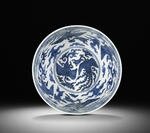A very fine and rare blue and white 'eight trigrams' bowl, Jiajing six-character mark and of the period
A very fine and rare blue and white 'eight trigrams' bowl, Jiajing six-character mark and of the period. Photo courtesy Bonhams
The interior with a central cartouche of two phoenixes chasing one another within a double-circle border, encircled by further four phoenixes in flight amidst wispyruyi-head cloud scrolls beneath a meandering vine scroll at the rim, the exterior with a continuous scene of flying cranes dividing eight trigrams above rockwork, all beautifully painted between upward plantain leaves at the foot and ruyi-head scrolls at the rim, the base with a six-character Imperial kaishu mark within double circles in underglaze-blue. 22.7cm diam. Estimate HK$ 2.5 million - 3 million (€240,000 - 290,000)
The eight trigrams represent the principles of yin and yangmanifested in the form of open and solid lines. Yin refers to the female and all that is passive, negative, dark and feminine; where yang refers to the male and all that is active, positive, light and masculine. The eight trigrams are positioned according to the Later Heaven arrangement, which can be found since the Song dynasty on ceramics; this signifies the bringing forth of information regarding the shifting of the yin and yang, revealing the Laws of Change in the universe and among the human world.
According to historical documents from the Jingdezhen Imperial kilns recorded by the Grand Gazetteer of Jiangxi province, jars with 'eight trigrams motif' favoured by Emperor Jiajing were made around the year 1542 during the twenty-first year of the Jiajing reign.
Eight trigrams on Jiajing period ceramics are related to Daoism and the practice of Inner Alchemy, whereby the Emperor heavily practiced Daoist rituals in obsessive hope of attaining immortality. Ceramic wares decorated with the eight trigram motifs would have been chosen to complement the Emperor's Inner Alchemy practices.
Another example of Jiajing period blue and white bowls with the 'eight trigram and crane motif' is in the Huaihaitang collection, illustrated in Enlightening Elegance. Imperial Porcelain of the Mid to Late Ming. The Huaihaitang Collection, Hong Kong, 2012, pp.212-213, 218-219 nos.51 and 54. See also another and white bowl dated to the Jiajing period but with dragon and Eight Immortals motif, illustrated in The Fame of Flame. Imperial Wares of the Jiajing and Wanli Periods, Hong Kong, 2009, pp.84-85, no.13.
Bonhams. FINE CHINESE CERAMICS AND WORKS OF ART. Hong Kong. 24 Nov 2013

/https%3A%2F%2Fprofilepics.canalblog.com%2Fprofilepics%2F1%2F0%2F100183.jpg)
/https%3A%2F%2Fstorage.canalblog.com%2F03%2F02%2F119589%2F96711876_o.jpg)
/https%3A%2F%2Fstorage.canalblog.com%2F11%2F31%2F119589%2F94773502_o.jpg)
/https%3A%2F%2Fstorage.canalblog.com%2F20%2F83%2F119589%2F94772815_o.jpg)
/https%3A%2F%2Fstorage.canalblog.com%2F26%2F72%2F119589%2F75604929_o.jpg)
/https%3A%2F%2Fstorage.canalblog.com%2F59%2F60%2F119589%2F26458628_o.jpg)





/image%2F1371349%2F20240416%2Fob_2a8420_437713933-1652609748842371-16764302136.jpg)
/image%2F1371349%2F20240414%2Fob_83ee65_2024-nyr-22642-0954-000-a-blue-and-whi.jpg)
/image%2F1371349%2F20240414%2Fob_15808c_2024-nyr-22642-0953-000-a-blue-and-whi.jpg)
/image%2F1371349%2F20240414%2Fob_e54295_2024-nyr-22642-0952-000-a-rare-blue-an.jpg)